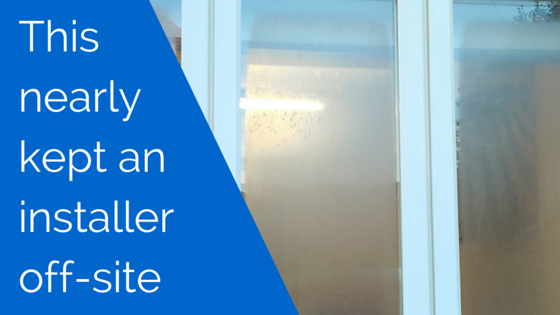>
For those who have been installing energy rated windows for the last couple of years, you will be all too aware of what this post is all about. Condensation.
When we started selling energy rated windows, one of the selling points was the fact that you could cut out a lot of the condensation on the inside of the windows. ‘Great’, we all thought, then ‘bugger’, soon afterwards. Providing the weather conditions are right, and the property is situated in the right place, energy rated windows actually condense on the outer pane. So as your customers wake up to a nice crisp winter morning, they can’t see a thing!
Problem is there isn’t much we can do about it. We now have to fit them by law, so there is no way to get round that. It also becomes increasingly harder to say to the customer that these reduce condensation, when 4-6 months of the year they might be steamed up on the outside! So what do we do?
We can either risk telling the customer upon demonstration of the windows, risking the cowboy competition saying that theirs don’t and allowing them to get one up on you. Or, fit the windows, knowing that weather conditions won’t always be conducive and it won’t always happen (providing it’s not a long cold winter like the last one!).
One thing to say to any customers that might ring up and complain is that it is proof the windows are doing their job, keeping your heat in, and the cold out. It’s a funny problem, and one which I don’t think anyone could even see coming.
When we started selling energy rated windows, one of the selling points was the fact that you could cut out a lot of the condensation on the inside of the windows. ‘Great’, we all thought, then ‘bugger’, soon afterwards. Providing the weather conditions are right, and the property is situated in the right place, energy rated windows actually condense on the outer pane. So as your customers wake up to a nice crisp winter morning, they can’t see a thing!
Problem is there isn’t much we can do about it. We now have to fit them by law, so there is no way to get round that. It also becomes increasingly harder to say to the customer that these reduce condensation, when 4-6 months of the year they might be steamed up on the outside! So what do we do?
We can either risk telling the customer upon demonstration of the windows, risking the cowboy competition saying that theirs don’t and allowing them to get one up on you. Or, fit the windows, knowing that weather conditions won’t always be conducive and it won’t always happen (providing it’s not a long cold winter like the last one!).
One thing to say to any customers that might ring up and complain is that it is proof the windows are doing their job, keeping your heat in, and the cold out. It’s a funny problem, and one which I don’t think anyone could even see coming.




>Same issue as Brewster Fringes, only happens in a perfectly parallel sealed unit. Sorry Madam you have perfect double glazing never seemed to satisfy them.